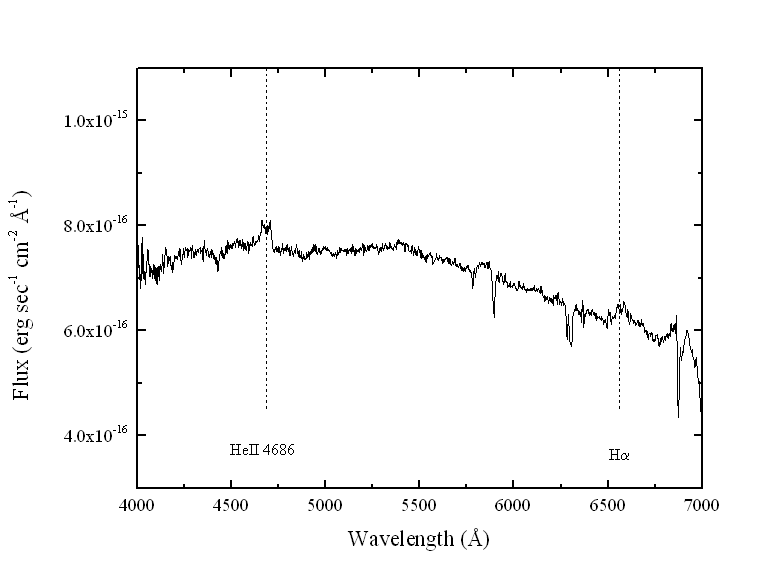Appearance of the broad emission lines in the optical spectrum of the black hole transient Swift J1753.5-0127
ATel #5307: Vitaly Neustroev (University of Oulu), Sergey Zharikov (Instituto de Astronomia, UNAM), George Sjoberg (AAVSO), Juri Poutanen, Alexandra Veledina (University of Oulu)
We report the appearance of the broad emission lines in the previously featureless optical spectrum of the black hole transient Swift J1753.5-0127.
The spectra of Swift J1753.5-0127 were obtained during four consecutive nights of August 6-9, 2013 at the Observatorio Astronomico Nacional (OAN SPM) in Mexico on the 2.1-m telescope with the Boller & Chivens spectrograph. A total of 54 spectra were obtained in the wavelength range of 3600-7000 A, in the first order of a 400 line/mm grating with corresponding spectral resolutions of about 3.4 A. The total exposure time was 750 mins. All the nights of observations were photometric, except for the first half of the second night (Aug 7) when cirrus clouds could have affected the flux level of the output spectra, with the seeing ranging from 1 to 2 arcsec. In order to apply an accurate flux correction, three standard spectrophotometric stars were observed every night. They were selected from Feige 110, HZ 44, BD+33 2642 and BD+28 4211.
The spectra exhibit very broad and double-peaked emission lines of HeII 4686 (FWHM ~3800 km/s, peak-to-peak separation ~2560 km/s, EW ~4 Angstrom) and Halpha (FWHM ~3200 km/s, peak-to-peak separation ~1800 km/s, EW ~4 Angstrom). There are also hints of He I emission lines (5875 A, 6678 A) and of the Bowen blend. We also detected a significant variability in the continuum shape that is confirmed by simultaneous photometry in the Johnson V and SDSS i filters which we obtained with a multi-channel imager RATIR on an accompanying 1.5-m telescope at the same site. In order to check the current photometric state of Swift J1753.5-0127 during our spectroscopic observations, we additionally obtained several sets of multicolour photometric data. These observations gave the following average magnitudes:
B=17.33+/-0.05, V=16.92+/-0.02, R_c=16.65+/-0.03, I_c=16.16+/-0.04.
The emission lines in the spectrum of Swift J1753.5-0127 were previously observed only at the very beginning of the current outburst started in 2005 (Torres 2005, ATEL #566). Since then, no spectral lines were detected until now. The existence of broad, double-peaked emission lines suggests their origin in an accretion disc. We note, however, that both Halpha and HeII 4686 lines are now much wider than they were observed at the beginning of the outburst. Torres et al. reported a peak-to-peak separation for Halpha to be 1200 km/s during their observations. It might suggest that the accretion disc of Swift J1753.5-0127 has shrunk by about 2 times compared to Torres et al.âs observations.
This entry was posted on Wednesday, August 21st, 2013 at 23:19 and is filed under Astronomy, Observations, Publications, Work. You can follow any responses to this entry through the RSS 2.0 feed. Both comments and pings are currently closed.

